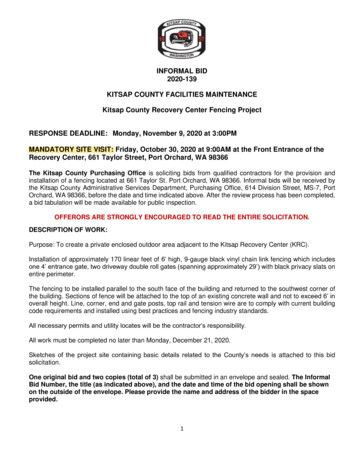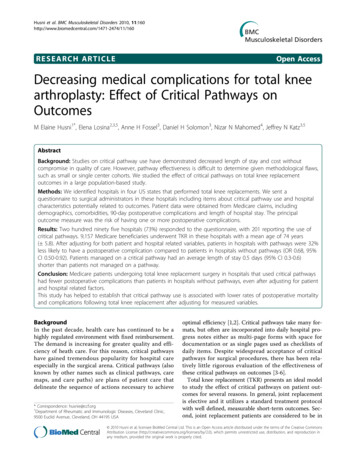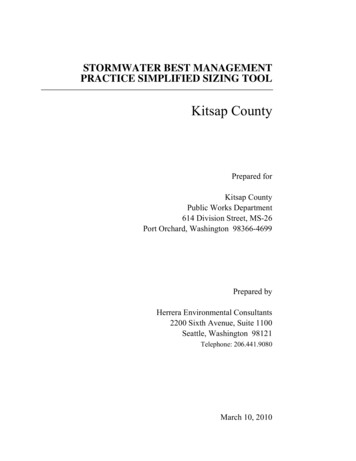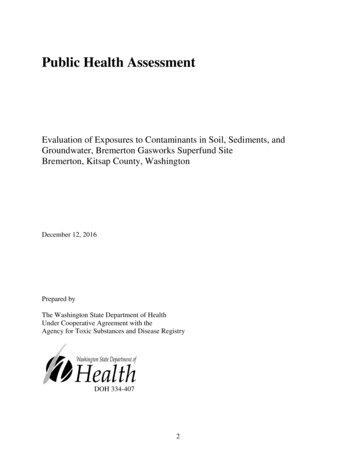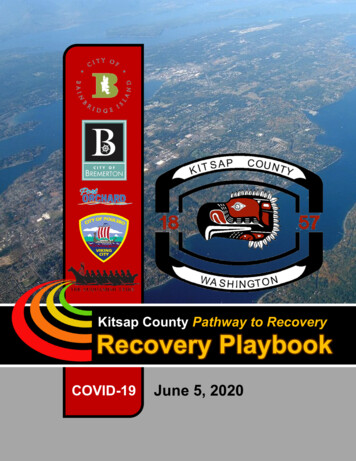
Transcription
Kitsap County Pathway to RecoveryRecovery PlaybookCOVID-19Kitsap CountyJune 5, 2020 1
Table of ContentsIntroduction . 1Kitsap County’s Four-Phased Pathway to Recovery. 1Purpose of this Playbook . 2Organization. 2Readiness and Capabilities Needed . 2Overarching Guidance for Individuals and Employers . 5Guidance for Individuals . 5Stay Home, Stay Healthy! . 5Guidance for All Employers. 5Role of Businesses and Employers in Responding to COVID-19 . 5Violation of Stay Home, Stay Healthy Orders . 6Decreasing the Spread . 6Child Care, Youth Development, and Summer Day Camps . 15Will Reopening be Consistent with Applicable State and Local Orders? . 22Are Recommended Health and Safety Actions in Place? . 22Is Ongoing Monitoring in Place? . 23Essential Businesses . 25Latest Guidance and Clarification . 25What is Considered Essential? . 25Healthcare/Public Health . 25Emergency Services Sector . 26Food and Agriculture . 27Energy. 28Water and Wastewater . 29Transportation and Logistics . 30Communications and Information Technology . 31Other Community-Based Government Operations and Essential Functions . 32Critical Manufacturing . 34Hazardous Materials . 34Financial Services . 34Chemical . 35Real Estate and Mortgage . 35Mortuary, Funeral, Embalmer, and Cemetery Services . 36Defense Industrial Base . 36Kitsap County Pathway to Recovery PlaybookPage i
Still Not Sure? . 36Essential Business Guidance . 37Construction Guidance – issued March 25 . 37Real Estate and Mortgage Guidance – issued March 27 . 37Funeral Guidance – issued March 28 . 38Automotive, Energy, Food and Agriculture, Healthcare/Public Health, In-Home Care, Maintenance,Recreation, Real Estate, and Retail Guidance – issued March 31 . 38Outdoor Guidance – issued April 27 . 40Elective Surgeries Guidance – issued April 29 . 43Essential Workforce Education Program Standards – issued May 7. 45Commercial Driver License Guidelines – issued May 7 . 48Recovery Phases. 51Phase 1. 52Phase 1 Business Activity Guidelines . 53Requirements for All Businesses . 53Phase 1 Recreation Guidelines . 72Phase 1 Gatherings Guidelines . 83Phase 2. 85Phase 2 Business Activity Guidelines . 86Phase 2 Recreation Guidelines . 109Phase 3. 117Phase 3 Business Activity Guidelines . 118Phase 3 Recreation Guidelines . 125Phase 4. 127Phase 4 Business Activity Guidelines . 128Phase 4 Recreation Guidelines . 129Phase 4 Gatherings Guidelines . 130Resources . 135Washington State Guidance . 135CDC Guidance . 135Other Federal Agencies and Partners. 135Kitsap County Pathway to Recovery PlaybookP a g e ii
IntroductionKitsap County’s Four-Phased Pathway to RecoveryOn May 4th, 2020 Governor Inslee signed Proclamation 20-25.3 and outlined the “Safe Start” plan, a data-driven, fourphased approach to reopen Washington and its counties and modify physical distancing measures while minimizingthe health impacts of COVID-19. This approach reduces the risk of COVID-19 to Washington’s most vulnerablepopulations and preserves capacity in our health care system, while safely opening up businesses and resuminggatherings, travel, shopping, and recreation. The plan involves assessing COVID-19 activity in the state along withhealth care system readiness, testing capacity and availability, case and contact investigations, and ability to protecthigh-risk populations in order to make the most informed decisions regarding reopening the county.Before reopening Kitsap County and modifying physical distancing measures, COVID-19 disease burden must be lowand decreasing as measured by: Number and trend of COVID-19 cases, hospitalizations and deaths in Washington State. Modeling data, including Institute for Disease Modeling on Puget Sound area rates of COVID-19 spread,University of Washington Institute for Health Metrics and Evaluation modeling, and Youyang Gu modeling. Mobility trends in Washington State, including WSDOT traffic data and Google Mobility Data.The following table shows the phased approach for reopening businesses and resuming activities not authorizedunder Proclamation 20-25. This phased approach may be adjusted as the pandemic evolves. The industries listed arenot an exclusive or exhaustive list of industries. Businesses listed in each phase of the plan will have industry-specificguidance and safety criteria developed to ensure workplace safety and public health are maintained. Those businessactivities are not authorized to open until the industry-specific guidance and safety criteria are issued.KITSAP COUNTY’S PHASED APPROACHModifying Physical Distancing Measures as We Reopen the State12Kitsap County Pathway to Recovery Playbook34Page 1
A number of different factors were considered when deciding which activities could be resumed and which businessescould be reopened in various phases. These factors included: Risk of disease spread during the individual or business activity. Number of people who could potentially be infected during the individual or business activity. Economic benefits to opening the business. Individual benefits to opening the business.Additional plans for a phased approach to restarting health care and educational activities are under development.Families are adjusting to a new way of life, and we understand the impacts this is having on them. The connectionbetween education, childcare, youth sports, summer programs and extracurricular activities is critical and must beviewed from a holistic lens to ensure equity and high quality of life. As we prepare for what the reopening of schoollooks like, the State will be working closely with the Department of Health; Office of the Superintendent for PublicInstruction; Department of Children, Youth and Families; and parents to release plans in the future. While childcare iscurrently an essential business activity and a key component to the reopening plan, we know there is more to do. Thestate will continue efforts to ensure adequate access and affordability for families.Purpose of this PlaybookThis Kitsap County Pathway to Recovery: Recovery Playbook was developed by the Kitsap CountyDepartment of Emergency Management (KCDEM) to help our community understand and safely embark uponour phased reopening.It is branded as a part of our emergency management Put a BIGFOOT Forward Towards Risk ReductionTMCampaign. As guidance around recovery may change, and later phases are still in development, this document will beupdated periodically as additional information is released.OrganizationThis document is organized in the following sections: Introduction Overarching Guidance for Individuals and Employers Essential Businesses Phase 1 Reopening Guidelines Phase 2 Guidelines Phase 3 Guidelines Phase 4 Guidelines ResourcesReadiness and Capabilities NeededThe State Department of Health and Kitsap County public health officials will monitor data to assess Kitsap County’sreadiness for safely reopening and modifying physical distancing measures. In addition to a low and decreasingdisease burden, readiness must be achieved in four key areas to proceed in the “Stay Home, Stay Healthy” order(Phase 1) to Phase 2, 3, and 4 of the plan. The four key areas include healthcare system readiness, testing capacityand availability, case and contact investigations, and ability to protect high-risk populations. The overall goals for eacharea, along with the pertinent data that will be considered, are detailed below and on the following page:1. Health Care System Readiness Adequate bed capacity, staffing and supplies in thehealth care system to handle a surge in COVID-19 cases, measured by: Number and percentage of licensed beds and ICU beds available in hospitals.Kitsap County Pathway to Recovery PlaybookPage 2
Number of available ventilators. Days of personal protective equipment (PPE) supply available at hospitals, long-term care facilities, andother health care settings. Ability of the state to fill high priority PPE requests from local emergency management agencies. Ability of hospitals and other health care facilities to surge and coordinate movement of patients.2. Testing capacity and availability ability for everyone with COVID-19 symptoms andthose with high-risk exposures to be tested immediately using a polymerase chainreaction (PCR) test and rapidly receive test results as measured by: Geographic distribution of testing sites and ability to serve the entire population. Number and capacity of laboratories in Washington performing COVID-19 testing. Availability of sufficient swabs, viral transport media, lab reagents, and other materials required forCOVID-19 testing. Number of tests performed per day.3. Case and contact investigations ability to rapidly isolate those with COVID-19, identifyand quarantine their contacts, and provide case management services as measuredby: Number of investigators trained and working. Plans for case management. Availability of isolation and quarantine facilities in local jurisdictions. Percent of cases investigated within 24 hours of receipt of positive test report. Percent of contact investigations initiated within 48 hours of receipt of positive test report.4. Ability to protect high-risk populations ability to immediately respond to outbreaks incongregate settings, such as long-term care facilities, behavioral health facilities,agricultural worker housing, homeless shelters and correctional facilities, and addressthe needs of other high-risk populations, including the elderly and the medically frail,measured by: Number of outbreaks in long-term care facilities. Demographic data, including race/ethnicity data, on COVID-19 cases, hospitalizations and deaths.Kitsap County Pathway to Recovery PlaybookPage 3
This page intentionally left blank.Kitsap County Pathway to Recovery PlaybookPage 4
Overarching Guidance forIndividuals and EmployersUntil there is an effective vaccine, effective treatment, or herd immunity, it is crucial to maintain some level ofcommunity interventions to suppress the spread of COVID-19 throughout all phases of recovery. This includesheightened protections for the health and safety of workers in essential sectors, people living and working in high-riskfacilities (e.g., senior care facilities) and all other workers.All Washingtonians and Kitsap County community members have a responsibility to protect themselves and others.Each phase, while allowing for additional services to open and return to full capacity, is grounded in the followingrequired basic practices:Guidance for IndividualsStay Home, Stay Healthy!To help stop the spread of COVID-19, Governor Inslee has asked Washington residents to stay home as much aspossible and do their part to keep everyone healthy. This is especially important as the state begins to graduallyreopen, and we work together to prevent outbreaks.All phases – Individuals should continue to: Engage in physical distancing, staying at least six feet away from other people. Wear cloth face coverings in public places when not eating or drinking (cloth face coverings should not beplaced on children younger than 2 years of age, anyone who has trouble breathing, or is unconscious,incapacitated or otherwise unable to remove the cover without assistance). Stay home if sick. Avoid others who are sick. Wash hands frequently with soap and water (use hand sanitizer if soap and water are not available). Cover coughs and sneezes. Avoid touching eyes, nose and mouth with unwashed hands. Disinfect surfaces and objects regularly.Guidance for All EmployersRole of Businesses and Employers in Responding to COVID19Businesses and employers can prevent and slow the spread of COVID-19 within the workplace. Employers shouldrespond in a way that takes into account the level of disease transmission in their communities and revise theirbusiness response plans as needed. Employers should follow the White House Guidelines for Opening Up AmericaAgain, a phased approach based on current levels of transmission and healthcare capacity at the state or local level,as part of resuming business operations. Business operation decisions should be based on both the level of diseasetransmission in the community and your readiness to protect the safety and health of your employees and customers.Businesses and employers are encouraged to coordinate with state and local health officials to obtain timely andaccurate information to inform appropriate responses. Local conditions will influence the decisions that public healthKitsap County Pathway to Recovery PlaybookPage 5
officials make regarding community-level strategies. CDC has guidance for mitigation strategies according to the levelof community transmission or impact of COVID-19.The Kitsap County Economic Development Alliance informs our local businesses, small and large, of critical, relevant,reliable information critical to assisting businesses in responding to and recovering from the COVID-19 crisis.http://kitsapeda.org/media-center/.As an employer, if your business operations were interrupted, resuming normal or phased activities presents anopportunity to update your COVID-19 preparedness, response, and control plans. All employers should implementand update as necessary a plan that: Is specific to your workplace, Identifies all areas and job tasks with potential exposures to COVID-19, and Includes control measures to eliminate or reduce such exposures.Talk with your employees about planned changes and seek their input. Additionally, collaborate with employees andunions to effectively communicate important COVID-19 information.See the Washington State Department of Labor & Industries guidance for more information on how to protect workersfrom potential exposures, according to their exposure risk. Plans should consider that employees may be ableto spread COVID-19 even if they do not show symptoms.Violation of Stay Home, Stay Healthy OrdersThe Governor’s Office warned Washington businesses that decide to open or operate in direct violation of Gov.Inslee’s Stay Home, Stay Healthy order may be cited and fined for unsafe workplace conditions under emergencyrules filed today by the state Department of Labor & Industries. The rules and the Safe Start Plan to reopenbusinesses are in place to keep workers and the public safe and to prevent the spread of the easily transmissiblecoronavirus.Decreasing the SpreadAll employers need to consider how best to decrease the spread of COVID-19 and lower the impact in yourworkplace. This should include activities to: Prevent and reduce transmission among employees, Maintain healthy business operations, and Maintain a healthy work environment.Prevent and Reduce Transmission Among EmployeesMonitor federal, state, and local public health communications about COVID-19 regulations, guidance, andrecommendations and ensure that workers have access to that information. Frequently check the CDC COVID-19website.Actively encourage sick employees to stay home. Employees who have symptoms should notify their supervisor and stay home. Sick employees should follow CDC-recommended steps. Employees should not return to work until the criteriato discontinue home isolation are met, in consultation with healthcare providers. Employees who are well but who have a sick family member at home with COVID-19 should notify theirsupervisor and follow CDC recommended precautions.Consider conducting daily in-person or virtual health checks (e.g., symptomand/or temperature screening) of employees before they enter the facility, in accordance withstate and local public health authorities and, if available, your occupational health services.Kitsap County Pathway to Recovery PlaybookPage 6
If implementing in-person health checks, conduct them safely and respectfully. Employers may use socialdistancing, barrier or partition controls, or PPE to protect the screener. However, reliance on PPE alone is aless effective control and is more difficult to implement, given PPE shortages and training requirements.oSee the “Should we be screening employees for COVID-19 symptoms?” section of General BusinessFrequently Asked Questions as a guide. Complete the health checks in a way that helps maintain social distancing guidelines, such as providing multiplescreening entries into the building. Follow guidance from the Equal Employment Opportunity Commission regarding confidentiality of medicalrecords from health checks. To prevent stigma and discrimination in the workplace, make employee health screenings as private aspossible. Do not make determinations of risk based on race or country of origin and be sure to maintainconfidentiality of each individual’s medical status and history.Identify where and how workers might be exposed to COVID-19 at work. Employers are responsible for providing a safe and healthy workplace. Conduct a thorough hazardassessment of the workplace to identify potential workplace hazards related to COVID-19. Use appropriatecombinations of controls from the hierarchy of controls to limit the spread of COVID-19, including engineeringcontrols, workplace administrative policies, and personal protective equipment (PPE) to protect workers fromthe identified hazards: Conduct a thorough hazard assessment to determine if workplace hazards are present, or are likely to bepresent, and determine what type of controls or PPE are needed for specific job duties. When engineering and administrative controls cannot be implemented or are not fully protective, employers arerequired by OSHA standards to:ooo Determine what PPE is needed for their workers’ specific job duties,Select and provide appropriate PPE to the workers at no cost, andTrain their workers on its correct use.Encourage workers to wear a cloth face covering at work if the hazard assessment has determined that they donot require PPE, such as a respirator or medical facemask, for protection.oSee the Washington State Department of Labor & Industries guidance for more information on how toprotect workers from potential exposures, according to their exposure risk.oCloth face coverings are not considered PPE. They may prevent workers, including those who don’t knowthey have the virus, from spreading it to others but may not protect the wearers from exposure to the virusthat causes COVID-19. Remind employees and customers that CDC recommends wearing cloth face coverings in public settings whereother social distancing measures are difficult to maintain, especially in areas of significant community-basedtransmission. Wearing a cloth face covering, however, does not replace the need to practice social distancing. See the OSHA COVID-19 webpage for more information on how to protect workers from potential COVID-19exposures and guidance for employers, including steps to take for jobs according to exposure risk.Separate sick employees. Employees who appear to have symptoms upon arrival at work or who become sick during the day shouldimmediately be separated from other employees, customers, and visitors, and sent home. Have a procedure in place for the safe transport of an employee who becomes sick while at work. Theemployee may need to be transported home or to a healthcare provider.Take action if an employee is suspected or confirmed to have COVID-19infection. In most cases, you do not need to shut down your facility. If it has been less than 7Kitsap County Pathway to Recovery PlaybookPage 7
days since the sick employee has been in the facility, close off any areas used for prolongedperiods of time by the sick person: Wait 24 hours before cleaning and disinfecting to minimize potential for other employees being exposed torespiratory droplets. If waiting 24 hours is not feasible, wait as long as possible. During this waiting period, open outside doors and windows to increase air circulation in these areas.If it has been 7 days or more since the sick employee used the facility, additional cleaning and disinfection is notnecessary. Continue routinely cleaning and disinfecting all high-touch surfaces in the facility.Follow the CDC cleaning and disinfection recommendations: Clean dirty surfaces with soap and water before disinfecting them. To disinfect surfaces, use products that meet EPA criteria for use against SARS-Cov-2, the virus that causesCOVID-19, and are appropriate for the surface. Always wear gloves and gowns appropriate for the chemicals being used when you are cleaning anddisinfecting. You may need to wear additional PPE depending on the setting and disinfectant product you are using. Foreach product you use, consult and follow the manufacturer’s instructions for use.Determine which employees may have been exposed to the virus and may need to take additional precautions: Inform employees of their possible exposure to COVID-19 in the workplace but maintain confidentiality asrequired by the Americans with Disabilities Act (ADA). Most workplaces should follow the Public Health Recommendations for Community-Related Exposure andinstruct potentially exposed employees to stay home for 14 days, telework if possible, and self-monitorfor symptoms. Critical infrastructure workplaces should follow the guidance on Implementing Safety Practices for CriticalInfrastructure Workers Who May Have Had Exposure to a Person with Suspected or Confirmed COVID-19.Employers in critical infrastructure also have an obligation to manage potentially exposed workers’ return towork in ways that best protect the health of those workers, their co-workers, and the general public.Educate employees about steps they can take to protect themselves at workand at home. Encourage employees to follow any new policies or procedures related to illness, cleaning and disinfecting, andwork meetings and travel. Advise employees to:oStay home if they are sick, except to get medical care, and to learn what to do if they are sick.oInform their supervisor if they have a sick family member at home with COVID-19 and to learn what todo if someone in their home is sick.oWash their hands often with soap and water for at least 20 seconds or to use hand sanitizer with atleast 60% alcohol if soap and water are not available. Inform employees that if their hands are visiblydirty, they should use soap and water over hand sanitizer. Key times for employees to clean theirhands include:o Before and after work shifts. Before and after work breaks. After blowing their nose, coughing, or sneezing. After using the restroom. Before eating or preparing food. After putting on, touching, or removing cloth face coverings.Avoid touching their eyes, nose, and mouth with unwashed hands.Kitsap County Pathway to Recovery PlaybookPage 8
oCover their mouth and nose with a tissue when they cough or sneeze or use the inside of their elbow.Throw used tissues into no-touch trash cans and immediately wash hands with soap and water for atleast 20 seconds. If soap and water are not available, use hand sanitizer containing at least 60%alcohol. Learn more about coughing and sneezing etiquette on the CDC website.oPractice routine cleaning and disinfection of frequently touched objects and surfaces such asworkstations, keyboards, telephones, handrails, and doorknobs. Dirty surfaces can be cleaned withsoap and water prior to disinfection. To disinfect, use products that meet EPA’s criteria for useagainst SARS-CoV-2, the cause of COVID-19, and are appropriate for the surface.oAvoid using other employees’ phones, desks, offices, or other work tools and equipment, whenpossible. Clean and disinfect them before and after use.oPractice social distancing by avoiding large gatherings and maintaining distance (at least 6 feet) fromothers when possible.For employees who commute to work using public transportation or ridesharing, consider offering the following support. Offer emp
Kitsap County Pathway to Recovery Playbook Page 1 Introduction Kitsap County's Four-Phased Pathway to Recovery On May 4 th, 2020 Governor Inslee signed Proclamation 20-25.3 and outlined the " Safe Start" plan, a data-driven, four-phased approach to reopen Washington and its counties and modify physical distancing measures while minimizing



